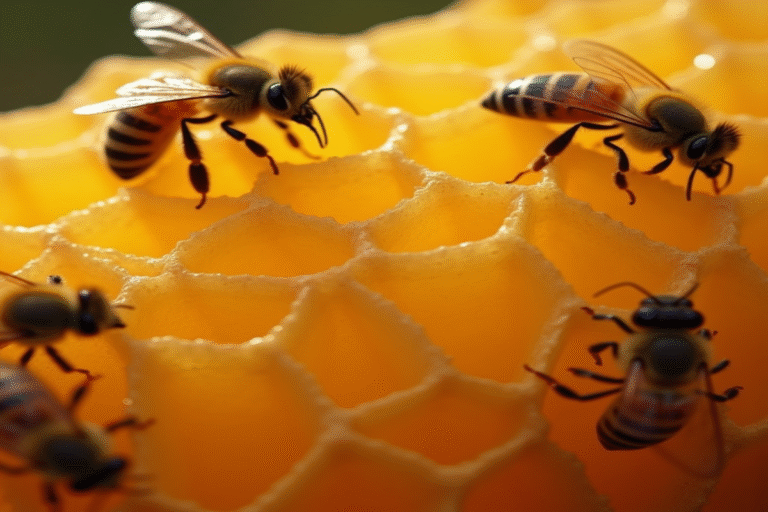When you observe a honeycomb up close, you’re witnessing one of nature’s most elegant mathematical marvels. Honey bees don’t just build homes—they construct architectural masterpieces that would make human engineers jealous. But how do these tiny insects, with brains smaller than a grain of rice, create such perfect hexagonal structures without rulers, protractors, or architectural training?
Nature’s Perfect Space-Savers
The hexagon isn’t just a random shape bees selected. In fact, it’s mathematically proven to be the most efficient structure for their needs. When bees need to create cells that:
- Pack together without gaps
- Use minimal building material
- Provide maximum storage space
…the hexagon is the best solution. The ancient Greek mathematician Pappus of Alexandria recognized this around 300 AD when he noted that hexagonal cells use less material than square or triangular ones of the same volume.
The Honeycomb Conjecture
For centuries, mathematicians suspected that hexagons were the most efficient way to divide a surface into regions of equal area with minimal total perimeter. This became known as the “honeycomb conjecture”—a mathematical problem that remained unproven until 1999 when mathematician Thomas C. Hales finally provided a rigorous proof.
The math shows that when dividing a plane into regions of equal area, the hexagonal grid uses about 30% less wax than a square grid and 40% less than a triangular grid. For bees, who must consume around eight ounces of honey to produce just one ounce of wax, this efficiency is crucial to their survival.
Do Bees Actually “Calculate” Hexagons?
Here’s where it gets fascinating: bees don’t actually set out to create hexagons! What happens involves both behavioral instincts and physics.
Bees begin by building cylindrical cells made of soft, warm wax. As these cylindrical cells cool and are packed tightly together, they naturally deform into hexagonal shapes through physical forces. The principle at work is one of minimal energy—the same principle that causes soap bubbles to form spheres in the air and hexagons when pressed together.
The hexagonal shape emerges from a process of self-organization that follows simple rules, not complex calculations. — Dr. Thomas Seeley, bee behavior expert
The Construction Process
The construction follows a remarkably precise sequence:
- Worker bees secrete wax scales from glands on their abdomen
- Other workers collect and chew these scales, softening them with saliva
- The softened wax is applied to form rough cylindrical cells
- As these cells cool and are packed together, surface tension forces them into hexagonal prisms
- The bees then carefully trim and adjust the angles to perfect 120-degree connections
The result is a structure that maintains a precise temperature of 93.5°F (34.2°C), ideal for raising young bees and storing honey. The walls are just 0.073 mm thick, yet strong enough to hold up to 30 times their weight in honey.
Mathematical Precision Beyond Hexagons
The mathematical wonder doesn’t stop at the hexagonal shape. Honeycomb cells aren’t simply hexagonal tubes—they’re actually rhombic dodecahedrons with specific angular precision. The bottom of each cell consists of three rhombi that meet at precisely 120-degree angles, creating a pyramidal shape that fits perfectly with adjacent cells on the opposite side of the comb.
In 1712, mathematician Giovanni Domenico Maraldi measured these angles at approximately 109.28 and 70.32 degrees. Later, Swiss mathematician Samuel König calculated the theoretically optimal angles for minimal wax use: 109.47 and 70.53 degrees. The bees’ actual construction differs from mathematical perfection by less than half a degree!
Learning From Bee Mathematics
This remarkable natural engineering has inspired numerous human applications:
- Architectural design: Hexagonal structures offer exceptional strength-to-weight ratios in buildings
- Material science: Honeycomb composites are used in aerospace for lightweight strength
- Packaging design: Hexagonal arrangements provide maximum protection with minimal material
- Solar energy collection: Hexagonal arrays maximize surface coverage for solar panels
The humble honeycomb reminds us that mathematical principles aren’t only human inventions—they are fundamental patterns woven into the fabric of nature. Through millions of years of evolution, honey bees have arrived at a solution that human mathematicians took centuries to prove.
Next time you see honey on your table, remember you’re looking at the product of one of nature’s most sophisticated mathematical designs—a sweet reminder that sometimes the smallest creatures reveal the greatest natural wisdom.





